Global Safety Footwear Trends That Indian Infrastructure Buyers Should Know

Global Safety Footwear Trends That Indian Infrastructure Buyers Should Know
As infrastructure projects in India scale rapidly, from highways to smart cities, logistics hubs, data centers, and industrial corridors, the demand for world-class safety footwear is rising. Indian buyers are no longer looking for basic protective shoes; they are aligning with global safety standards, advanced materials, and emerging ergonomic features that minimize risk and enhance worker productivity.
Global Footwear Safety Trends You Must Look For
Here are the leading global trends shaping the future of industrial safety footwear and what Indian infrastructure buyers should pay attention to before making their next procurement decision.
1. Shift Toward Lightweight and High-Comfort Safety Footwear
Globally, industrial footwear is moving away from heavy, bulky shoes toward lightweight yet equally protective designs. This trend is being driven by:
- Advanced composite toe caps replacing steel
- EVA and PU midsoles that improve cushioning
- Engineered knit uppers for breathability
- Ergonomic designs that mimic athletic shoes
For Indian infrastructure sites where workers stand or walk for long hours, these comfort-focused designs improve compliance and reduce fatigue-related accidents.
2. Rise of Composite Toe Technology
Composite toe caps are becoming the global standard due to their combination of strength and comfort. They offer:
- High impact resistance
- Lower weight
- No conductivity, ideal for electrical or thermal environments
- Compliance with international protection norms
For sectors like metro rail construction, power plants, and industrial EPC projects, composite toe footwear is now preferred over conventional steel toe options.
3. Anti-Slip and Multi-Surface Outsoles Are Becoming Mandatory
With increasingly complex project sites, wet surfaces, loose gravel, steel platforms, and sloped ramps, global manufacturers are prioritizing specialized outsole technologies, such as:
- Deep, multi-directional tread patterns
- Heat-resistant and abrasion-resistant rubber compounds
- Anti-slip materials designed for oil, water, and chemical exposure
These features directly reduce slip-and-fall incidents, one of the most common causes of workplace injuries. For Indian buyers, anti-slip footwear is quickly moving from optional to essential.
4. Advanced Electrical and ESD Protection
As infrastructure integrates more electrical systems, data centers, EV charging stations, industrial automation, and transmission infrastructure, safety footwear is now expected to meet Electrical Hazard (EH) or Electrostatic Discharge (ESD) standards.
Global trends show:
- Shoes designed to prevent electric shock during accidental contact
- Footwear that dissipates static charge to protect sensitive equipment
- Materials engineered for high dielectric strength
Indian industrial clusters increasingly adopting automation and electrical systems will benefit from this protective upgrade.
5. Material Innovation: From Leather to Engineered Synthetics
While leather remains popular, the global shift is toward engineered synthetic materials that provide superior protection and flexibility:
- Water-resistant microfibers
- Abrasion-resistant synthetic leather
- Breathable knitted uppers
- Recyclable or eco-friendly compounds
These materials are lighter, quicker to dry, and more durable in extreme conditions, especially beneficial for humid, dusty, or chemical-prone Indian worksites.
6. Thermal and Heat-Resistant Footwear Gains Popularity
Projects involving welding, forging, metal fabrication, foundries, heavy engineering, and road construction now require footwear that withstands:
- High heat exposure
- Sparks and metal splatter
- Hot surfaces
Globally, heat-resistant soles and fire-retardant uppers are becoming standard for heavy industry, and Indian infrastructure procurement is quickly aligning with these requirements.
7. Increasing Adoption of Sustainable and Eco-Friendly Safety Footwear
Environmental compliance is now a key global driver. Safety footwear manufacturers are responding with:
- Recycled uppers and insoles
- Water-based adhesives
- Long-life soles designed to reduce landfill waste
- Energy-efficient production processes
Indian companies bidding for international projects or seeking ESG alignment can benefit from adopting sustainable PPE.
8. Compliance with Global Standards: The New Benchmark
International standards are influencing procurement decisions worldwide, and Indian infrastructure buyers are increasingly adopting them to improve quality and reduce workplace risks. The most influential standards include:
- ISO safety footwear classifications for impact, compression, and resistance
- EN ISO 20345 standards from Europe
- ASTM standards from the US
- Specialty certifications for heat, chemicals, electricity, and puncture resistance
Aligning with global standards ensures product reliability, better worker protection, and easier audit compliance for multinational contracts.
9. Smart Footwear and Digital Monitoring: The Next Wave
Early-stage innovations also include:
- Pressure-sensitive smart insoles
- RFID-enabled footwear for workforce tracking
- Embedded sensors that monitor posture or fatigue
While still emerging, these technologies are expected to shape the future of industrial safety in high-value infrastructure projects.
What This Means for Indian Infrastructure Buyers
As project timelines shorten and worker safety becomes a central performance metric, buyers must select footwear that aligns with:
- Advanced global safety expectations
- High comfort, long-wear performance
- Hazard-specific protection
- Certified quality assurance
- Material durability for extreme Indian conditions
Incorporating global trends into procurement strategy ultimately leads to fewer injuries, higher worker morale, and improved productivity.
Conclusion
Global safety footwear trends are shaping a new era of industrial protection, one driven by comfort, innovation, compliance, and sustainability. However, if you are looking for top-quality safety shoes, then Moglix is the right platform to procure them in bulk. For Indian infrastructure buyers, staying aligned with these trends ensures that every worker on-site is equipped with footwear that not only meets today’s safety requirements but is also ready for tomorrow’s challenges.
Top 10 Sanitary Ware And Bathroom Fittings Brands In India 2026: Types And Price Comparison

Top 10 Sanitary Ware And Bathroom Fittings Brands In India 2026: Types And Price Comparison
Bathrooms have gone from purely functional rooms to mini-spas, and the brand you pick affects design, water-use, durability, and maintenance. Here’s a clear, buyer-friendly guide to the top 10 sanitary ware brands in India (2026), what they’re best at, typical product types, and realistic price ranges to expect.
A good bathroom accessories brand gives consistent quality, spare-part availability, warranties, local service, and water-efficient models. For industrial bulk buying and home users, the pick is a trade-off between cost, design, and long-term reliability. Premium bathroom fitting brands bring design + tech (sensor taps, rimless EWCs, smart showers), while mainstream brands focus on value and wide service networks. Additionally, sanitary ware materials play a major role in strengthening various types of bathroom fittings. You can buy sanitary ware materials like steel frames, moisture protection, thermal protection, etc, at Moglix.
Check Out The List Of Top Sanitary Brands In India
While shopping for bathroom fittings and accessories, the very first step is to check for various brands and their offerings based on the requirement. Therefore, for a comprehensive purchase, we have curated a list of the top sanitary ware brands in India:
CERA: Consistent all-rounder (Great value & wide range)
What they make: One-piece EWCs, wall-hung toilets, washbasins, faucets, shower systems, wellness (tubs/steam).
Why pick CERA: Strong presence across price tiers, detailed MRP catalogues make price comparisons easy. Good for buyers who want modern styling without ultra-premium pricing.
Hindware: Mass market leader (Wide dealer network)
What they make: Sanitaryware (toilets, basins), faucets, showers, CP fittings, bathroom accessories.
Why pick Hindware: Exceptional availability across India, strong mid-range offerings, and frequent promotions on e-commerce. Good choice for refurbishments where service & spares matter.
Jaquar: Fittings specialist (Premium to luxury)
What they make: Extensive bath fittings range (mixers, showers, concealed systems), also sanitaryware under Jaquar/Artize.
Why pick Jaquar: Known for design language, finishes (matt/black/graphite), a wide range of shower solutions, and entire bathroom systems for coordinated looks. Strong warranty/support for fittings.
Kohler India: Global premium (Design + innovation)
What they make: Premium EWCs, basins, faucets, showers, bathtubs, and smart toilets.
Why pick Kohler: Global premium brand reputation, strong design collaborations, durable finishes, and smart toilet technologies. Ideal for high-end bathrooms.
Roca / Parryware: Reliable heritage brands
What they make: Sanitaryware (Parryware is Roca’s India arm), faucets, cisterns, and bathroom furniture.
Why pick them: Trusted history in India, good mid-to-premium ranges, and strong OEM presence; Parryware products often balance cost and style well.
Grohe: German engineering (Fittings specialist)
What they make: Faucets, showers, concealed systems, bathroom accessories.
Why pick Grohe: Precision engineering, silky flow control, and long-lasting chrome finishes. Excellent for buyers who prioritise faucet/shower performance and finish quality.
TOTO: Japanese tech leader (Sanitaryware + smart toilets)
What they make: High-quality EWCs, washlets (bidet-toilet combos), basins, urinals.
Why pick TOTO: Known for water-efficient flushing tech, rimless bowls, and advanced washlets (warm water, air dryer), good for luxury and hygiene-focused buyers.
Duravit: European premium (Design + ceramics)
What they make: Designer sanitaryware, basins, bathtubs, and bathroom furniture.
Why pick Duravit: Collaborations with prominent designers (Philippe Starck, etc.), strong on aesthetics and modern minimalism. Suited to architect-led projects.
Somany / Simpolo / Vitrified brands: Ceramic specialists
What they make: Sanitaryware, tiles, some faucets, and bathroom systems.
Why pick them: Good value, domestic manufacturing strength, wide dealer networks, and competitive pricing, often chosen for full-home projects where tile + sanitary coordination matters.
Niche & specialty brands (Kerovit, VitrA, Prayag, others)
What they make: Regionally strong sanitaryware and fittings; some focus on budget or specialty segments.
Why pick them: If you want very specific budgets, designs, or rapid local service, these brands can be the best value option.
Quick price comparison table
How to choose: 6 practical tips
- Decide core priorities: water savings, low maintenance, design, or budget. Smart toilets/ sensor taps add cost but reduce long-term hassle.
- Match finishes: pick one finish family (chrome/black/matt) across faucets and accessories for a coordinated look.
- Check warranty & spares: choose brands with authorized service centres in your city — saves time later. Hindware and Jaquar have deep dealer networks; premium brands offer authorised installers.
- Measure before you buy: check trap distances and cistern compatibility for replacement projects.
- Water pressure & system compatibility: some rain showers or concealed mixers need minimum pressure; verify with product specs.
- Look for water-saving labels: dual-flush EWCs, aerated taps, and flow-restricting showers reduce bills over time.
Where to buy & verify prices in Bulk
If you are looking for model-level MRPs and effective prices, then you can opt for brand catalogues and marketplace listings like Moglix for reliable and hassle-free procurement of sanitary and bathroom fittings. Always compare SKU, finish, and warranty before checkout. If you are looking to buy sanitary ware in bulk, then Moglix is the best online platform to procure them easily at the most competitive price from various truncated and above-mentioned brands.
Final thoughts
For 2026, the Indian market continues to be split between reliable mass-market names (Hindware, CERA, Somany) and feature/design leaders (Jaquar, Kohler, Grohe, TOTO). If you want the safest long-term bet for spares and service, go with a widely distributed brand; if the bathroom is a showpiece, budget for a premium or designer brand, and remember: good installation matters as much as the brand you pick.
What Is Bitumen: Types, Uses, Importance, and Price (Complete guide)
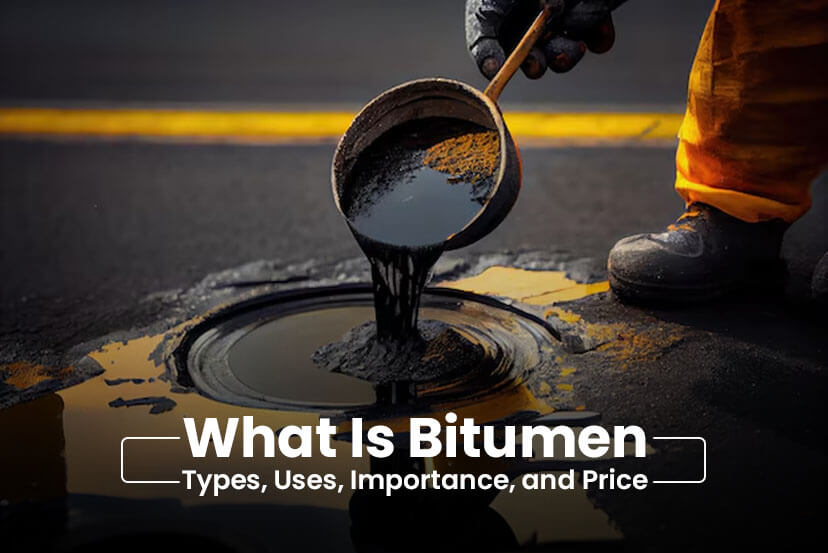
What Is Bitumen: Types, Uses, Importance, and Price (Complete guide)
As we are heading towards an advanced construction and infrastructure era, industries and businesses are also evolving their strategies to streamline the use of high-quality materials, ensuring durability and long-lasting performance. Therefore, in the construction of roads, Bitumen stands as one of the pivotal materials known for its strong binding and waterproofing properties.
Whether you are a bulk procurement team, a construction industry, or any other type of buyer, it is essential to understand Bitumen, recognizing its critical role in modern infrastructure, including its various uses, types, and pricing, to make better decisions before buying bitumen online in bulk from various platforms. This comprehensive guide below will assist you in knowing the in-depth information about Bitumen.
What Is Bitumen?
When it comes to Bitumen, most people are unaware of its basic definition. In simple terms, Bitumen is a viscous, Black, and sticky petroleum-based substance that is extracted during the filtration of crude oil. It plays a major role in binding the materials during road construction, roping, and waterproofing membranes due to its various properties. In overall aspects, it acts as an adhesive to hold all the construction aggregates used in asphalt and pavement road construction
Bitumen is known for its:
- Strong adhesive properties
- Excellent resistance to water
- High durability
Understand the various Types of Bitumen
Before the procurement of Bitumen, it is necessary to know about its various types to select the right type for specific purposes. Let’s have a look at them:
- Penetration Grade Bitumen
These types of bitumen are mostly used in road construction and are available in various grades, like 30/40, 40/50, 60/70, and 80/100. In simple terms, the harder the bitumen is, the lower its penetration, whereas, softer the bitumen is, the higher its penetration. It is best for hot climate regions and heavy traffic roads.
- VG (Viscosity Grade) Bitumen
It is the new composition of bitumen that has replaced the penetration grade in many countries. You can find the various grades like VG-10 (Used in cold climate roads), VG-20 (used in moderate traffic roads), VG-30 (Used for high traffic highways), VG-40 (Extremely high duty pavements).
- Cutback Bitumen
It is a perfect mixture of various solvents and bitumen, which makes it easier to apply at lower temperatures and zones. Therefore, Outback Bitumen is best for cold-weather pavements and patch repairs.
- Emulsion Bitumen
When bitumen is mixed with emulsifiers and the right water percentage, then emulsion bitumen is derived. They are further divided into two types, Cationic and Anionic, which are perfect materials used for cold mixed roads, tack coats, and slurry sealing.
- Polymer Modified Bitumen (PMB)
This bitumen is mixed with polymers, crumb rubber, and SBS. These are mostly used for high-stress roads and airport runways. PMB bitumen offers long-lasting performance and high elasticity.
- Oxidized Bitumen
This type of bitumen is prepared at high temperature by blowing air through the bitumen. These are mostly used for roofing and waterproofing.
What are the various Uses of Bitumen?
When it comes to the uses of Bitumen, it is one of the most essential and trending materials covering a wide industry:
- Road construction
One of the most pivotal applications of bitumen, acting as a binding agent of asphalt concrete for highways, pothole patching, and even pavement coatings. It ensures long-lasting performance by creating a strong bond among various construction aggregates.
- Waterproofing
Biumen is also widely used as a waterproofing agent and plays a pivotal role in building roof membranes, basements, and foundation protection, and sealing water tanks. It prevents water leakage and eliminates the risk of moisture damage.
- Building & Construction
In building and construction projects, bitumen is used in the expansion of joints, enhancing flooring protection, and developing damp-proof coatings.
- Industrial Applications
In industries, Bitumen is used for coating cables, powerful adhesive for binding, and as a soundproofing material.
- Airport Runways
For building smooth, powerful, and long-lasting airport runways, PMB bitumen is used to enhance the overall performance to hold heavy loads.
Acknowledge the Importance of Bitumen
Bitumen comes with amazing and unique properties to elevate the modern infrastructure, such as:
- High durability: It improves the strength of the roads to hold heavy loads and perform robustly in harsh climates.
- Water-Resistant: Bitumen consists of amazing waterproofing properties that make it an effective and efficient material in roofing and underground structures.
- Cost-Effective: Bitumen is affordable and provides long-term value as compared to any other binding agent.
- Recyclable: The biggest advantage of bitumen is its ability of recycled and can be reused in the formation of roads, reducing the cost and environmental impact.
- Good adhesion: One of the most effective and strong adhesive properties, ensuring strong asphalt surfaces.
What is the Bitumen Price in India (2025 Updated)
The price of bitumen may vary based on type, location, and manufacturer. However, we have given an estimated value for every specific type of bitumen you can find market.
- VG-10 Bitumen Price: The price fall between ₹45,000 – ₹48,000 per MT
- VG-20 Bitumen Price: The price fall between ₹47,000 – ₹50,000 per MT
- VG-30 Bitumen Price: The price fall between ₹48,000 – ₹52,000 per MT
- VG-40 Bitumen Price: The price fall between ₹50,000 – ₹55,000 per MT
- Polymer Modified Bitumen (PMB) Price: The price falls between ₹65,000 – ₹80,000 per MT
- Cutback Bitumen Price: The price falls between ₹55,000 – ₹65,000 per MT
- Emulsion Bitumen Price: The price falls between ₹35,000 – ₹42,000 per MT
Where to Buy Bitumen Online in Bulk – Why Moglix Is a Good Option?
As the bitumen demand is rising day by day, it has led industries to buy it regularly. It may be daunting to procure them quickly, but at Moglix Business, we ensure the procurement of Bitumen from reliable and trusted sources and manufacturers. Now you can buy bitumen online in bulk at our platform and get it delivered quickly across various places throughout India. We have a complete collection of various Bitumens used for different purposes, including VG-10, VG-30, VG-40, crumb-rubber modified bitumen (CRMB), polymer-modified bitumen (PMB), and bitumen emulsion at the most competitive prices. With the recent collaboration and launch of the Bitumen production facility, DRG Bitumen Industries, in July 2025, Moglix ensures to connect the buyers and suppliers effectively and provide a hassle-free supply chain reliability across India.
Conclusion
Bitumen has been a priority for various road construction industries, known for its high durability and waterproofing properties. It has showcased its various applications throughout different industries and plays a critical role in modern infrastructure development. With the comprehensive blog, you must understand the importance, uses, and types of Bitumen you can opt for. So, it’s time to elevate the quality and strength of construction and infrastructure by procuring top-notch Bitumen at Moglix.
What Is AAC Block? Types, Uses, Features, and Importance
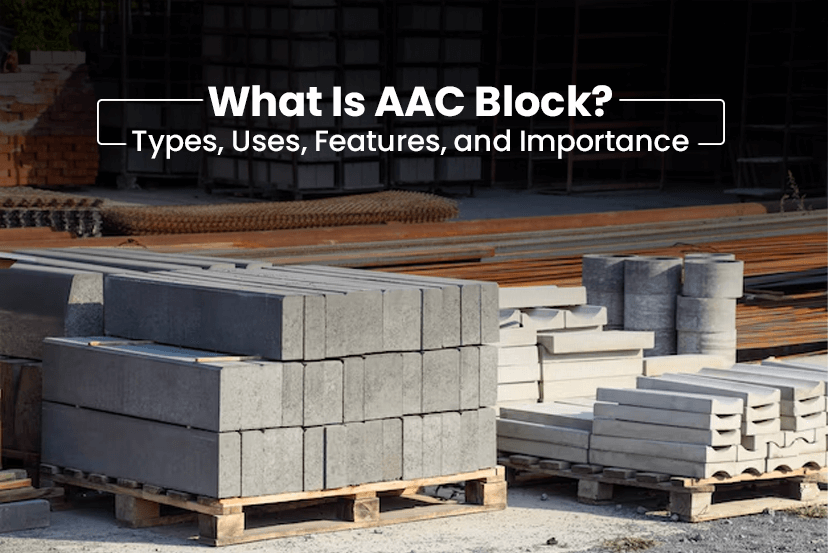
What Is AAC Block? Types, Uses, Features, and Importance
In modern construction, balancing strength, cost, speed, and sustainability is crucial. One building material that meets all these requirements is the AAC block. Widely used in residential, commercial, and industrial projects, AAC blocks have transformed the way walls are constructed in India and across the globe. This blog explains what AAC blocks are, their types, uses, features, and importance, helping you decide whether they are right for your next construction project.
What does an AAC Block mean?
AAC block full form is Autoclaved Aerated Concrete block, which is a lightweight precast building material made from cement, lime, fly ash, sand, water, and an expanding agent. Through a controlled manufacturing process and high-pressure steam curing (autoclaving), AAC blocks develop a porous, honeycomb-like structure that gives them high strength while keeping them extremely lightweight. Compared to traditional red bricks, AAC blocks are larger, lighter, more uniform, and offer better thermal and acoustic insulation.
How AAC Blocks Are Made?
- Raw materials such as cement, fly ash, lime, and sand are mixed.
- Aluminum powder is added to create air bubbles through a chemical reaction.
- The mixture expands and is cut into blocks or panels.
- The blocks are cured in an autoclave under high pressure and temperature.
- Final products are tested for strength, density, and quality.
Understand The Various Types Of AAC Blocks
AAC blocks are categorized based on density, size, and application:
1. Load-Bearing AAC Blocks
- Higher density and compressive strength
- Suitable for low-rise buildings
- Reduce the overall dead load on the structure
2. Non-Load-Bearing AAC Blocks
- Lower density
- Used for partition walls and infill walls
- Ideal for high-rise buildings with RCC frames
3. AAC Blocks Based on Density
- Low Density (400–500 kg/m³): Excellent insulation, used for partitions
- Medium Density (550–650 kg/m³): Commonly used for residential and commercial walls
- High Density (700 kg/m³ and above): Used where higher strength is required
4. AAC Panels (Advanced Type)
- Large, reinforced AAC panels
- Used for flooring, roofing, and cladding
- Speed up construction significantly
What Are The Uses Of AAC Blocks
AAC blocks are highly versatile and are used across various construction segments:
- Residential buildings – houses, apartments, villas
- Commercial structures – offices, malls, hotels
- Industrial buildings – warehouses, factories
- High-rise buildings – partition and infill walls
- Boundary walls and compound walls
- Fire-resistant walls and acoustic barriers
Have An Eye On The Key Features Of AAC Blocks
1. Lightweight Construction
AAC blocks weigh nearly one-third of traditional bricks, reducing structural load and foundation cost.
2. High Compressive Strength
Despite being light, AAC blocks offer sufficient strength for both load-bearing and non-load-bearing applications.
3. Excellent Thermal Insulation
The air pores in AAC blocks provide superior insulation, keeping buildings cooler in summer and warmer in winter.
4. Sound Insulation
AAC blocks effectively reduce noise, making them ideal for residential and commercial spaces.
5. Fire Resistance
AAC blocks are non-combustible and can withstand high temperatures for up to 4–6 hours, enhancing building safety.
6. Eco-Friendly Material
Manufactured using fly ash, a byproduct of thermal power plants, AAC blocks support sustainable construction.
7. Precise Dimensions
Uniform size and smooth surfaces reduce mortar usage and plaster thickness.
8. Faster Construction
Larger block size and easy handling speed up masonry work and reduce labor costs.
What Is an AAC Block Price Based on Sizes?
Here’s a quick breakdown of approximate per-piece rates for different thicknesses of AAC block (Autoclaved Aerated Concrete block) in India, though actual price may vary depending on region, brand, order quantity, and delivery charges:
- 4-inch AAC block: around ₹ 45 – ₹ 55 per piece.
- 6-inch AAC block: roughly ₹ 65 – ₹ 85 per piece.
- 8-inch AAC block: approximately ₹ 85 – ₹ 110 per piece.
Importance of AAC Blocks in Modern Construction
1. Cost Efficiency
Although AAC blocks may have a higher initial cost, they reduce expenses related to:
- Cement and mortar
- Steel consumption
- Plaster thickness
- Construction time
This makes the overall project more economical.
2. Structural Safety
Lower dead weight minimizes seismic impact, making AAC blocks suitable for earthquake-prone areas.
3. Energy Efficiency
Better insulation means reduced dependence on air conditioners and heaters, lowering long-term energy costs.
4. Sustainable Building Solution
AAC blocks contribute to green building certifications and help reduce carbon footprint.
5. Long-Term Durability
AAC blocks resist termites, mold, and moisture-related damage, ensuring a longer lifespan of structures.
AAC Blocks vs Red Bricks (Quick Comparison)
| Feature | AAC Blocks | Red Bricks |
| Weight | Very light | Heavy |
| Size | Large and uniform | Small and uneven |
| Thermal Insulation | Excellent | Limited |
| Construction Speed | Fast | Slow |
| Material Wastage | Minimal | High |
| Eco-Friendliness | High | Moderate |
Conclusion
AAC blocks have emerged as smart, sustainable, and cost-effective building materials for modern construction. With advantages like lightweight structure, excellent insulation, high fire resistance, and eco-friendliness, AAC blocks outperform traditional bricks in almost every aspect. Whether you are constructing a home, commercial complex, or industrial facility, you can buy AAC blocks at Moglix Business in bulk from reputed and trusted brands that offer long-term benefits in terms of safety, cost savings, and energy efficiency.
What Is Kadappa Stone: Types, Prices, Importance, And Features
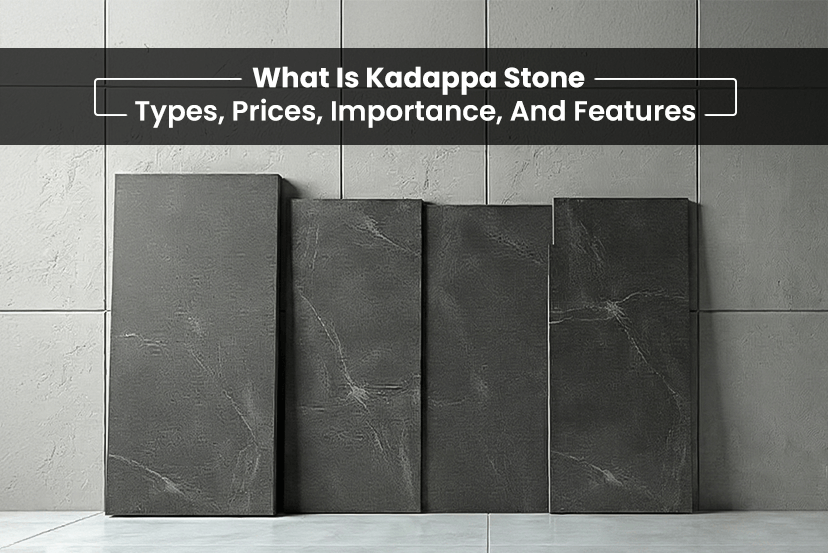
What Is Kadappa Stone: Types, Prices, Importance, And Features
Kadappa stone is one of the most widely used natural stones in Indian construction and architecture. Known for its durability, smooth finish, and cost-effectiveness, Kadappa stone has been a preferred choice for flooring, kitchen slabs, and religious spaces for decades. In this blog, we’ll explore what Kadappa stone is, its types, prices, importance, and key features, helping you decide if it’s the right material for your project.
What Is Kadappa Stone?
Kadappa tiles/stone (also spelled Kadappa or Cuddapah stone) is a fine-grained limestone primarily quarried in and around the Kadapa district in the state of Andhra Pradesh. It is typically dark grey to black in color and is valued for its uniform texture and ability to take a smooth finish.
The kadappa stone flooring has been used historically in temples, homes, and public buildings due to its long life and ease of maintenance.
What Are The Different Types of Kadappa Stone?
Kadappa tile is mainly categorized based on finish, thickness, and application:
1. Natural Kadappa Stone
- Raw or semi-polished surface
- Commonly used for traditional flooring and base slabs
2. Polished Kadappa Stone
- Smooth, refined finish
- Ideal for indoor flooring, staircases, and countertops
3. Leather Finish Kadappa Stone
- Matte, textured surface
- Provides better slip resistance for outdoor areas
4. Calibrated Kadappa Stone
- Uniform thickness
- Preferred for commercial flooring where precision is required
Types of Kadappa Stone Based on Color
Kadappa stone is commonly associated with darker shades, but based on mineral composition, quarry location, and processing techniques, it is available in multiple color variations. Each color type has its own visual appeal, applications, and advantages.
1. Grey Kadappa Stone
Grey Kadappa stone is one of the most commonly used variants, available in light grey to dark grey shades. It offers a neutral, modern appearance and blends well with most interior themes.
- Smooth texture and uniform finish
- Less prone to showing dust and stains
- Available in natural, polished, and matte finishes
Ideal For: Indoor flooring, hallways, commercial spaces, and staircases
2. Black Kadappa Stone
Black Kadappa stone is the most premium and traditional variety. Its deep black color gives a classic and elegant look, especially after polishing.
- High density and strong load-bearing capacity
- Popular choice for temples and kitchen platforms
- Creates a rich contrast with light-colored interiors
Ideal For: Kitchen slabs, pooja rooms, steps, and heavy-traffic areas
3. White Kadappa Stone
White Kadappa stone is a rare and processed variant, usually achieved through surface treatment and finishing. It provides a lighter and more contemporary appearance compared to traditional dark Kadappa stones.
- Brightens interior spaces
- Gives a marble-like effect at a lower cost
- Requires proper sealing and regular maintenance
Ideal For: Indoor flooring, decorative areas, and low-traffic residential spaces
4. Green Kadappa Stone
Green Kadappa stone features subtle green hues mixed with grey tones due to natural mineral presence. It is less common and mostly used for aesthetic or customized projects.
- Natural earthy appearance
- Unique color variation compared to standard Kadappa stone
- Available mainly in natural or leather finishes
Ideal For: Accent flooring, outdoor sit-outs, verandas, and landscape areas
Comparison of Kadappa Stone Colors
| Color Type | Shade Range | Appearance | Best Usage |
| Grey Kadappa Stone | Light to dark grey | Modern & neutral | Indoor flooring |
| Black Kadappa Stone | Deep black | Premium & classic | Kitchens, temples |
| White Kadappa Stone | Off-white to light grey | Bright & elegant | Decorative areas |
| Green Kadappa Stone | Grey-green tones | Natural & earthy | Outdoor & accents |
Kadappa Stone Prices In India
Kadappa stone costs vary depending on thickness, finish, and quality. Below is a general price range for reference:
| Type | Thickness | Approx. Price (₹/sq ft) |
| Natural Finish | 20 – 25 mm | Rs 25 – Rs 35 |
| Polished Finish | 20 mm | Rs 35 – Rs 55 |
| Leather/Matt Finish | 20 mm | Rs 40 – Rs 60 |
| Calibrated Stone | 18 – 20 mm | Rs 50 – Rs 70 |
Note: Prices may change based on location, transportation cost, and order quantity.
Importance of Kadappa Stone
Kadappa stone plays a significant role in Indian construction because of its balance between performance and affordability.
- Economic: Much cheaper than marble and granite
- Traditional Value: Widely used in temples and heritage buildings
- Structural Strength: Suitable for high-traffic areas
- Local Availability: Easy sourcing within India
Its versatility makes it suitable for both modern and traditional architectural styles.
Key Features of Kadappa Stone
1. High Durability: Kadappa stone can withstand heavy loads and continuous foot traffic, making it suitable for residential and commercial use.
2. Smooth and Uniform Texture: Its fine-grain structure allows smooth polishing and a neat, elegant appearance.
3. Non-Slippery Options: Leather and matte finishes provide slip resistance, especially useful for wet areas.
4. Low Maintenance: Requires minimal cleaning and does not stain easily when properly sealed.
5. Cost-Effective Alternative: Offers a natural stone look at a fraction of the cost of premium stones.
Common Uses of Kadappa Stone
- Flooring in homes and apartments
- Kitchen platforms and shelves
- Staircases and steps
- Temple flooring and pooja rooms
- Outdoor pathways and sit-outs
Conclusion
Kadappa tiles/stone remains a cornerstone of Indian construction due to its durability, affordability, and versatile applications. With multiple finishes, reliable strength, and widespread availability, it continues to be a smart choice for both residential and commercial projects. Now you can buy kadappa stones in bulk at Moglix businesses at the most competitive prices for construction. Whether you’re building a new home or renovating an old space, Kadappa stone offers practical value without compromising longevity.
Top 10 CPVC Pipe Companies In India: Comparison and Latest Rank
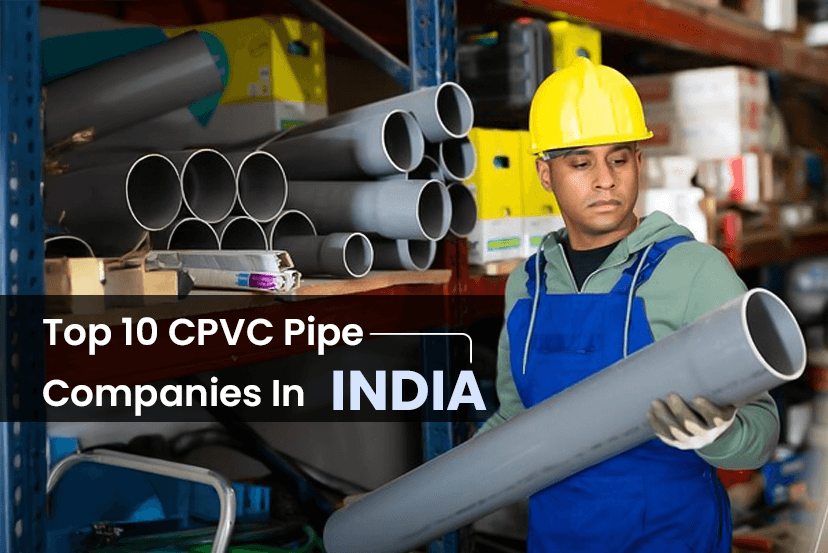
Top 10 CPVC Pipe Companies In India: Comparison and Latest Rank
In modern infrastructure and construction, CPVC pipes are used for plumbing fittings to improve the hot and cold-water distribution, especially in Indian residential homes and several types of industries and commercial buildings. Therefore, the PVC pipes market in Indian remains one of the most competitive, with several brands focusing on robust and improving the quality to increase their sales. However, it may be a little confusing to find the best PVC pipe according to your project requirements. To eliminate all kinds of challenges while choosing a PVC pipe brand, we have collected the data of the Top 10 CPVC pipe brands in India (2025) based on long-established polymer majors and specialist pipe manufacturers who combine certified raw materials, wide distribution, and large after-sales networks
Which is the best CPVC pipe in India? Check out the Top 10 list
Before you plan to buy CPVC pipe and fittings, it is necessary to know about the top brands offering the best pipes according to your project requirements. Have a quick look at the list below:
Astral Pipes
Astral Pipes continues to dominate the Indian market in 2025 and is widely regarded as the pioneer of piping systems in India. The brand is known for premium-quality CPVC pipes, fittings, and solvent cements used extensively in residential, commercial, and industrial plumbing. With a strong dealer network and high brand trust, Astral is often the first choice for builders and large infrastructure projects where reliability and long service life are critical.
Supreme Industries
Supreme Industries is one of India’s largest plastic processing companies and a leader in plumbing solutions. Its Lifeline CPVC pipes are popular for hot and cold-water applications in homes, hospitals, and institutions. Supreme is valued for consistent quality, wide availability, and competitive pricing, making it a solid choice for both individual homeowners and large contractors.
Prince Pipes & Fittings
Prince Pipes has rapidly grown into a major pipe manufacturer with a strong presence across India. Known for its modern manufacturing facilities and expanding product portfolio, the brand focuses heavily on CPVC plumbing solutions for residential and commercial use. Prince Pipes is often preferred in bulk housing and construction projects due to its scalable supply and reliable performance.
Ashirvad Pipes
Ashirvad Pipes, part of a global plumbing solutions group, is recognized for high-specification CPVC systems made using certified compounds. The brand is especially popular for premium homes, hotels, and hospitals, where performance under high temperature and pressure is essential. Ashirvad emphasizes international-quality standards, durability, and leak-proof jointing systems.
Finolex Industries
Finolex has a long-standing reputation in India’s piping industry and offers a trusted CPVC range for hot and cold-water distribution. Its CPVC pipes are widely used in residential buildings, government projects, and institutions. Buyers often choose Finolex for its brand legacy, dependable quality control, and strong service support.
Vectus Industries
Vectus is a fast-growing name in the CPVC pipe segment with a strong dealer network across North and South India. The company focuses on providing cost-effective yet certified CPVC plumbing solutions suitable for homes and mid-sized commercial projects. Vectus has gained popularity for decent quality, availability, and practical pricing.
Apollo / APL Apollo Pipes
Apollo Pipes offers a comprehensive plumbing solution portfolio, including CPVC pipes and fittings. The brand has a strong regional presence and is commonly used in residential and light commercial plumbing. Apollo CPVC pipes are known for good finish, reliable joints, and competitive pricing.
Skipper / Jain Irrigation / Kisan Group
These brands collectively represent well-established Indian manufacturers with strong regional reach. Their CPVC pipes are commonly used in housing projects, irrigation-linked infrastructure, and budget-conscious constructions. They offer a wide range, making them suitable for contractors handling large-volume orders.
Ajay Pipes / Prayag / Ocean Pipes
These brands are trusted by regional players in CPVC plumbing systems. They are frequently used in local housing projects where certified CPVC products are required at economical prices. Performance is generally reliable when genuine products are purchased through authorized dealers.
Local & Regional CPVC Brands
Several small and regional manufacturers supply CPVC pipes across India. While they may offer lower prices, quality can vary significantly. These brands are best considered only for small projects and after proper verification of certifications, thickness, pressure ratings, and warranty terms.
Which Is the Best Pipe Brand? Quick Comparison Table
| Rank | Brand | HQ / Founded | CPVC focus / Strengths | Certifications / Notes |
| 1 | Astral | Ahmedabad (pioneer | Large volumes, premium CPVC systems, and strong distribution | Corporate reports show leading market position & FY25 results. |
| 2 | Supreme | Mumbai (1942) | Broad plastic portfolio; Lifeline CPVC range for hot & cold | Product literature & technical guides. |
| 3 | Prince Pipes | Mumbai (1987) | Integrated piping player, CPVC focus in investor presentations | CPVC growth outlook in Q4 FY25 investor deck. |
| 4 | Ashirvad | Bengaluru (Aliaxis) | Specialist plumbing brand; uses NSF/TempRite certified CPVC resin | The manufacturer claims NSF-grade raw material & FlowGuard tech. |
| 5 | Finolex | Pune / Ratnagiri roots | Longstanding pipe maker; CPVC range for hot/cold & solar water heaters | Product pages list BIS/CIPET/ASTM compliance. |
| 6 | Vectus | Kerala / Noida presence | Wide dealer network; certified CPVC offerings for plumbing | Corporate product pages & tech blogs. |
| 7 | APL Apollo / Apollo | Chennai / pan-India | Large polymer group; CPVC in plumbing portfolio | Widely available via dealers. |
| 8 | Skipper / Jain / Kisan | Various | Regional strength, wide SKU range | Good for budget and regional projects. |
| 9 | Ajay / Ocean / Prayag | Regional | Competitive pricing, used in smaller projects | Check local service & certification. |
| 10 | Local brands | Regional | Low cost, variable quality | Buy only after checking specs & tests |
Buying Guide: How To Pick the Right CPVC Pipes
Buying CPVC pipes without any additional information or guidance may create problems in later stages of operation. Therefore, know your requirement first and buy the best CPVC pipes based on the application and purpose.
Check the application first
- Domestic hot/cold water (most CPVC use): choose CPVC rated for hot water (Vicat/heat deflection specs) with appropriate SDR/pressure class.
- Solar water heaters / high temp: select CPVC rated for higher sustained temperatures.
Always verify certifications
- Look for BIS / IS compliance (Indian Standards), NSF (where claimed), ASTM D2846 or equivalent test reports, and third-party lab certificates (CIPET / CFTRI) where available. Brands like Ashirvad and Finolex publicly state these standards.
Material & raw-material provenance
- CPVC performance depends on the resin and compounding. Brands that disclose resin source and in-house QC are preferred for long-life performance.
Pressure rating & schedule (SDR)
- Verify pressure rating at operating temperature ratings drop at higher temperatures. Choose a pressure class suitable for your building’s static pressure and pump systems.
Fittings & jointing system
- Use OEM fittings and recommended solvent cement/primer from the same manufacturer for leak-proof joints. Avoid mixing cheap generic CPVC pipe fittings; they may have different tolerances.
Final Checklist Before You Buy
- Manufacturer name & product code printed on the pipe
- SDR / pressure class & wall thickness match spec
- Third-party/ manufacturer test certificates available (BIS/ASTM/NSF/CIPET)
- OEM fittings & adhesive recommended by the maker
- Warranty terms & local dealer availability confirmed
- Installer trained in CPVC solvent-weld techniques
Closing summary
In 2025, the CPVC pipe landscape in India is dominated by a few strong national players (Astral, Supreme, Prince, Ashirvad, Finolex) plus a healthy mid-market (Vectus, Apollo, Skipper, Jain, Kisan) and many regional suppliers. For most buyers, choosing a brand backed by verifiable certifications, a strong dealer network, and clear installation guidance will deliver the best long-term value. When in doubt, prefer Top 10 CPVC pipe brands in India (2025) for certified products from listed brands and insist on OEM fittings and official installation manuals.
What Is Fabrication and How Does It Work?
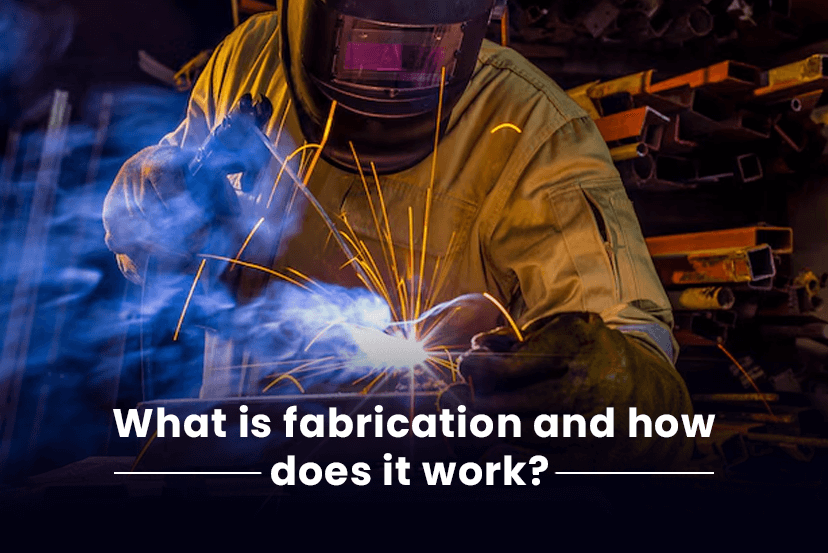
What Is Fabrication and How Does It Work?
In today’s manufacturing-driven world, fabrication plays a vital role in transforming raw materials into functional products used across industries. From construction and automotive to electronics and industrial machinery, fabrication is the backbone of modern production. But what exactly is fabrication, and how does it work? Let’s explore the concept in detail, step by step.
What does fabrication work mean?
Focusing on the Fabrication work means the process of converting raw materials into finished or semi-finished products using various industrial techniques such as cutting, bending, assembling, welding, and finishing. Unlike simple assembly, fabrication involves reshaping and modifying materials to meet design and functional requirements.
Fabrication work is commonly associated with metals, but it also applies to plastics, glass, wood, composites, and electronic components.
What are the Types of Fabrication
Fabrication methods vary depending on material, use cases, and industry.
1. Metal Fabrication
Metal fabrication involves transforming metals like steel, aluminum, copper, and iron into usable components. It is widely used in:
- Construction
- Automotive manufacturing
- Aerospace and heavy machinery
2. Structural Fabrication
This type focuses on creating load-bearing structures such as beams, frames, and columns, commonly used in bridges, buildings, and factories.
3. Sheet Metal Fabrication
Sheet metal fabrication uses thin metal sheets to create enclosures, cabinets, ducts, and panels through cutting and bending processes.
4. Industrial Fabrication
Industrial fabrication produces large-scale equipment, machines, and customized tools used in manufacturing plants and heavy industries.
How Does Fabrication Work? (Step-by-Step Process)
Fabrication usually follows a well-structured process to ensure accuracy, strength, and quality. If you want to know the complete process of fabrication work, check out the steps listed below.
Step 1: Design and Engineering
The process begins with technical drawings or CAD (Computer-Aided Design) models. These designs specify:
- Dimensions
- Materials
- Tolerances
- Functional requirements
Step 2: Material Selection
Raw materials are selected based on:
- Strength requirements
- Environmental conditions
- Cost efficiency
- Durability and corrosion resistance
Common materials include steel, stainless steel, aluminum, and alloys.
Step 3: Cutting
Cutting is used to shape materials into required sizes using tools such as:
- Laser cutting
- Plasma cutting
- Waterjet cutting
- Sawing and shearing
Accurate cutting ensures minimal material wastage and precise dimensions.
Step 4: Forming and Bending
In the forming and bending stage, flat or straight materials are reshaped using:
- Press brakes
- Roll forming machines
- Forging techniques
Forming adds strength and allows components to fit together correctly.
Step 5: Assembly and Welding
Multiple parts are joined using:
- Welding
- Bolting
- Riveting
- Adhesives
Welding is the most common method, ensuring high strength and structural integrity.
Step 6: Machining
Machining refines fabricated parts to achieve high precision using:
- Drilling
- Turning
- Milling
- Tapping
This step ensures parts meet tight tolerances and exact specifications.
Step 7: Finishing and Surface Treatment
Finishing improves appearance, durability, and corrosion resistance. Common finishing techniques include:
- Painting
- Powder coating
- Polishing
- Galvanizing
- Anodizing
Step 8: Quality Inspection
The final step involves inspection and testing to ensure:
- Dimensional accuracy
- Structural strength
- Safety compliance
- Surface quality
Quality control prevents defects and ensures reliability.
Tools and Equipment Used in Fabrication
Fabrication relies on specialized machinery, such as:
- CNC machines
- Laser cutters
- Welding machines
- Press brakes
- Grinding and polishing tools
Advanced fabrication facilities often use automation and robotics for improved efficiency and consistency.
Applications of Fabrication
Fabrication processes are used across multiple sectors, including:
- Construction and infrastructure
- Automotive and transportation
- Power plants and the energy sector
- Electronics and appliances
- Furniture and consumer goods
Almost every physical product we use today has undergone some form of fabrication.
Advantages of Fabrication
Fabrication plays a vital role in modern manufacturing because it offers flexibility, efficiency, and reliability across industries. Below are the key advantages of fabrication, explained clearly and practically:
Customization and Design Flexibility
Fabrication allows products to be custom-made according to specific requirements. Whether it’s size, shape, material, or finish, fabrication supports tailor-made solutions that standard products cannot offer.
High Strength and Durability
Fabricated components are designed to withstand heavy loads, pressure, and harsh environments. Advanced joining and forming techniques ensure strong, long-lasting structures.
Cost-Effective Production
Fabrication helps reduce overall costs by:
- Minimizing material waste
- Enabling bulk production
- Reducing rework and errors
Precision and Accuracy
Modern fabrication uses CNC machines and automated tools, ensuring tight tolerances and high dimensional accuracy. This results in consistent quality and minimal defects.
Faster Production Time
With automated cutting, welding, and forming processes, fabrication significantly reduces production lead time, enabling faster project completion and quicker market delivery.
Future of Fabrication
The future of fabrication lies in:
- Automation and robotics
- AI-driven design and quality checks
- Additive manufacturing (hybrid fabrication)
- Sustainable and eco-friendly materials
Conclusion
Fabrication is a core manufacturing process that turns raw materials into functional, high-quality products used across industries. Understanding what fabrication is and how it works helps businesses make informed decisions, improve production efficiency, and achieve better product quality.
Whether it’s a simple metal component or a large industrial structure, fabrication remains essential to modern engineering and industrial growth.
CPHI India 2025
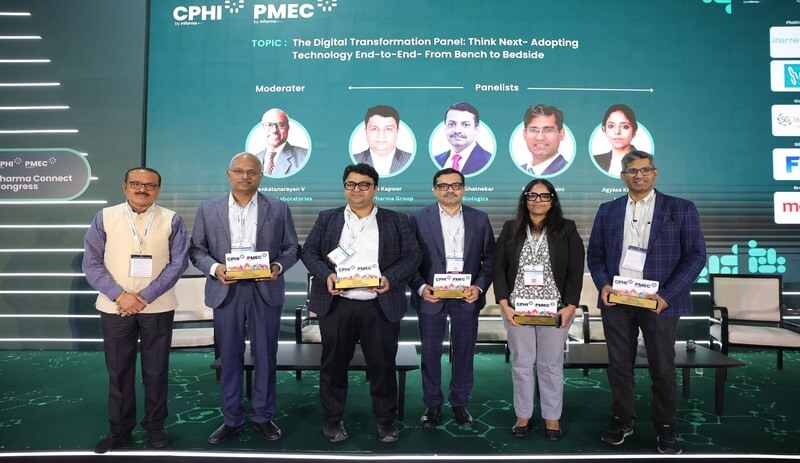
CPHI India 2025
Date: 25th-27th Nov
Organizer: CPHI
About the Event: Ms. Jigyasa Kishore, Vice President, Moglix, spoke at CPHI India 2025 on the panel, “Think Next – Adopting Technology End-to-End: From Bench to Bedside.
Top 10 Tiles Company In India: Latest And Updated Rank (2025-2026)
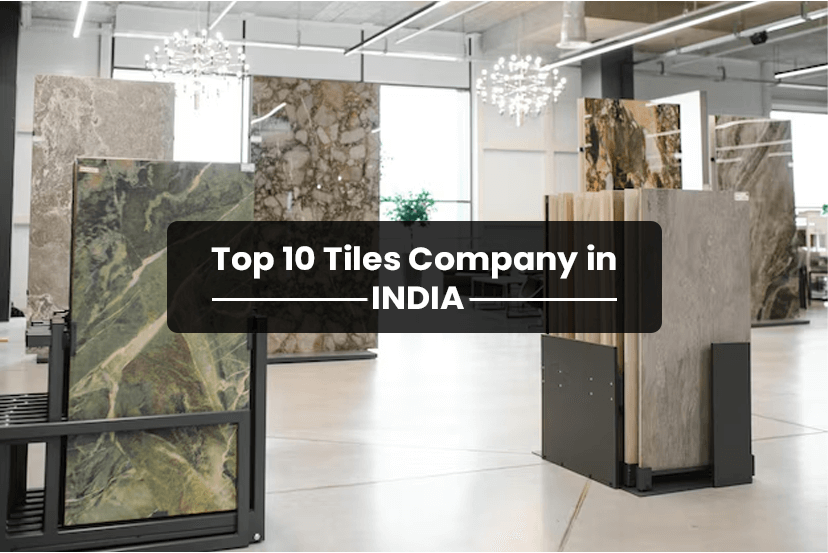
Top 10 Tiles Company In India: Latest And Updated Rank (2025-2026)
The usage of tiles has become quite common in the construction industry. They not only improve the aesthetics but alsi affect the durability and long-lasting performance. The fast-growing infrastructure and construction industries demand top quality and the best tiles to improve the overall infrastructure, whether it is used for residential or official purposes. However, while buying tiles online in bulk, you need to understand the project requirement and opt for the best tile company, who offer a wide range of robust and high-performing tiles at the most reasonable prices. Therefore, Moglix is the right platform to buy tiles online in bulk from reputed and reliable brands and suppliers. To make your purchase hassle-free, we have collected the latest data and elaborated the list of the top 10 tile companies in India you can rely on for various projects.
How Did We Pick The List Of The Best Tiles Company In India?
Based on the priority, we have collected the data of those tile companies which have strong manufacturing capacity, a wide range of categories (porcelain, ceramic, Vitrified, large slabs, etc), R&D innovation, good market presence, and are trusted by users. Therefore, you can chekc out the list of the top ten tile companies in India based on the above criteria and procure them effortlessly at Moglix.
What are the top 10 brands of tiles? Here is the complete list
Before you plan to buy tiles online, it is necessary to understand every specific brand and what makes them stand out from the crowd:
Kajaria Ceramics: Kajaria is widely cited as India’s largest tile manufacturer and one of the biggest globally in terms of capacity. They have an extensive range of tiles such as ceramic, glazed vitrified, polished vitrified, and large-format tiles, and a strong retail & project presence. Kajaria’s investor and corporate materials explicitly state their manufacturing scale and national footprint.
Best for: Large-format and premium vitrified tiles for residential and commercial projects.
Somany Ceramics: Somany Tiles has also created a long legacy in India and offers a wide catalog of tiles for various purposes, such as floor and wall tiles, vitrified tiles, and bathware tiles. The brand’s main objective is to meet the market standards with modern infrastructure and availability across India. The market positioning is also cool and highlights the efficiency of products through their interactive and easy-to-market website, making them one of the best tile brands in India.
Best for: A reliable mid-to-premium range with strong after-sales and expansive dealer network.
Asian Granito (AGL): Asian Granito is an emerging brand and has captured the trust of customers through their quality tiles at reasonable prices. They are known for rapid capacity growth and quality rating reports, offering a wide range of the best tiles.
Best for: Vitrified tiles, large-format slabs, and export-grade products.
Orientbell Tiles: If your priority is an appealing design with durability, Orientbell Tiles can be the best option to opt for. The competitive pricing and pan-India strong retail presence make them fall in the list of the top 10 tile brands in India. What makes them stand out is the thousands of designs and nationwide delivery footprints.
Best for: Designer floor and wall tiles with strong value-for-money and wide availability.
RAK Ceramics (India): RAK Ceramics is a global ceramics giant with major manufacturing capacity and an established India business. Their product quality and global experience make them a preferred supplier for premium interiors and larger projects.
Best for: Premium porcelain, porcelain slabs, and coordinated sanitaryware solutions.
NITCO: You can’t ignore the legacy of NITCO tiles, which was established in the 1950s and known for their high-quality designer tiles and ephaises on the premium section of retail experience. They have maintained the quality of tiles and a large number of showrooms to target the design-conscious buyers.
Best for: Designers, terrazzo-inspired tiles, and premium curated collections.
Simpolo: Simploe is also one of the well-recognized brands for offering a wide range of vitrified and bathroom tiles. They have elevated their marketing presence for innovation and robust tiles used for various purposes. It is also one of the best options for home architecture.
Best for: Innovative vitrified tiles and coordinated bathware collections.
Varmora Granito: Varmora has grown strongly over the past couple of decades with multiple manufacturing units and a broad export footprint. The company promotes extensive retail outreach and a diverse tile portfolio (porcelain, vitrified, ceramic). Recent business news also shows investor interest and corporate activity.
Best for: Large-scale supply, export-grade porcelain & vitrified tiles.
H&R Johnson (Johnson Tiles / HRJ): H&R Johnson is also one of the prestigious and oldest brands in India. They have been pioneer in providing a variety of tiles for industrial and social function places, which come with features like anti-static and parking tiles.
Best for: Industrial applications, parking & heavy-traffic tiles, and heritage reliability.
CERA: No one can ignore CERA tiles, especially known for their top-notch tiles and sanitarywares. They have one of the most influential marketing and people have shown trust in their top-quality tile solutions. Businesses and industries looking to procure CERA tiles in bulk at Moglix and install the best tiles, and a convenient choice.
Best for: Complete bath + tiles solutions and streamlined retail experience.
Quick comparison table of the Best tile companies in Indian with
Final thoughts
India’s tile market includes reliable legacy names and nimble newer players. The aforementioned list of top 10 tile brands in India for 2026 can assist you in choosing the right tile for a specific project. If you want durability and wide service support, go with long-established, large-capacity brands (Kajaria, Somany, H&R Johnson). If your priority is designer looks or specialty terrazzo/porcelain aesthetics, consider NITCO, Simpolo, RAK, or Asian Granito. For the best value with broad retail reach, Orientbell and Varmora are strong choices.
Top 10 Vendor Management Best Practices in 2026
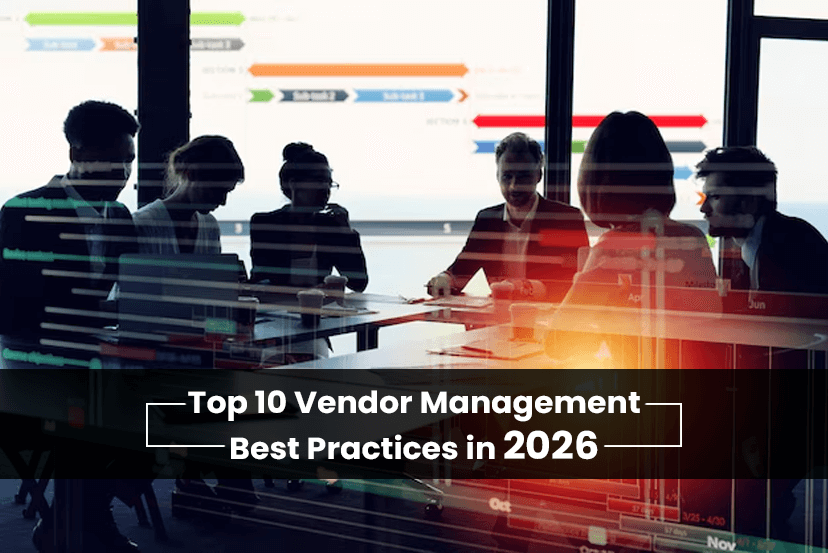
Top 10 Vendor Management Best Practices in 2026
Vendor management is the most essential part of any business, which has elevated its horizons more than just supplying goods. It means, the proper utilization of the vendor management process assists businesses in delivering quality products to end customers, enhancing customer satisfaction, and improving business reputation. Therefore, day by day, vendor management has become the priority for every online-to-offline business, a strategic way for organizations to drive business seamlessly. As we all know, the importance of managing vendors reduces the cost, minimizes risk, and builds a long-term relationship with every supplier and manufacturer.
However, many businesses still do not have enough understanding of vendor management, which may lead to business inefficiency. Therefore, below we have explained the top 10 vendor management practices that can significantly improve your procurement efficiency and vendor performance.
What Is Vendor Management?
Vendor management’s meaning is quite simple, yet one needs to understand the depth, since it is a perfect and overall structure of selecting, onboarding, monitoring, and managing the relationship with third-party suppliers to acquire and get the best goods and services for your business. Generally, the Vendor management process ensures vendors meet the quality standards, deliver the products or services on time, and support the overall growth of your company by fulfilling th targets and goals.
How To Manage Vendors: 10 Tips To Manage Vendors Seamlessly
To manage your vendors and drive your business growth, you can follow the tips below. It will help you to manage your suppliers and manufacturers effortlessly. Let’s have a quick look at every specific tip:
Create a Strong Vendor Selection Strategy
When we say managing vendors, the very first thing is to begin th journey with choosing the right supplier partner for your business. Therefore, before onboarding a vendor, you need to evaluate a few things, like
- Industry expertise
- Product or service quality
- Delivery capabilities
- Certifications and compliance
- Pricing transparency
- Customer reviews and references
Define Clear Contracts and SLAs
Businesses need to showcase their requirements and intentions towards vendors and then create a handful and concise contracts and SLAs. The unreliable contract may lead to delays, disputes, and even financial losses. Therefore, you need to outline clear goals such as:
- Scope of work
- Performance expectations
- delivery timelines
- Quality standards
- Pricing and payment terms
- Penalties for non-compliance
Maintain Consistent and Transparent Communication
Communication is the core part of vendor management to mitigate misunderstandings and ensure proper alignment of the supplies. You can follow the ways to establish better clarity with the vendors:
- Assign a dedicated point of contact
- Set up structured communication schedules
- Use collaboration tools and vendor portals
- Share regular forecasts and updates
Regularly Evaluate Vendor Performance
Regular monitoring of vendor performance and work reliability eliminates the arising issues of supply and delivery. You need to adhere to useful KPIs, which include:
- On-time delivery rate
- Quality defect percentage
- Responsiveness
- Compliance level
- Cost accuracy
Implement a Vendor Risk Management System
Every vendor comes with some kind of operational, financial, and reputational risk, for which you can integrate a vendor risk management system. Some of the risk control measures include such as:
- Conducting due diligence
- Tracking financial stability
- Ensuring data security compliance
- Creating backup or alternate vendors
- Performing regular audits
Focus on Building Long-Term Vendor Relationships
The main goal and priority must be to build a long-term vendor relationship to drive th business continuity without any hurdles and start-stop situations. Therefore, you need to consider vendor relationship management best practices, such as:
- Give constructive feedback
- Recognize top performers
- Share business goals
- Encourage collaboration
- Offer training or support
Enable Vendor Development and Capability Building
Focusing on the development of vendors also improves the capability of your business to grow. This means establishing the relationship beyond transaction and collaborating to strengthen the wider relationships. This strategy includes
- Joint training programmes
- Quality improvement workshops
- Technology support
- Performance feedback sessions
Adopt Digital Tools for Vendor Management
Handling the vendor through a manual process increases the chances of errors and inconsistency in data. Therefore, adopting a digital tool for vendor management can simply elevate the complete vendor management process and evaluate the insights faster. Some useful digital solutions include:
- Vendor Management Systems (VMS)
- Procurement software
- Automated invoicing tools
- Spend analytics dashboards
- Inventory Management/Supplier portals
Create a Smooth and Transparent Payment Process
Establishing a smooth and reliable transaction process elevates the process of managing vendors. Payment delays can hurt relationships and damage vendor trust, which may lead to service inconveniences. You can simply improve the transaction by:
- Automating invoice approvals
- Maintaining clear payment cycles
- Quickly addressing disputes
- Offering visibility into payment status
Establish an Exit Plan for Underperforming Vendors
In case the vendor fails to meet the standards and expectations, it is the prime responsibility to design a proper strategy for exit to protect your business continuity. A responsible exit plan includes
- Notice periods
- Final settlements
- Documentation transfer
- Inventory or asset recovery
- Transition to alternative vendors
Final Thoughts
Strong vendor management is not just about reducing costs; it’s about building a dependable supply chain, reducing business risk, and enhancing overall performance. By applying these top 10 vendor management practices, businesses can create more stable partnerships, improve quality, and achieve consistent growth in 2025 and beyond.
